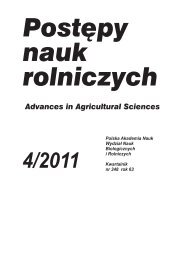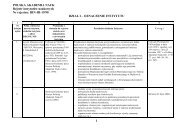Postepy nauk rolniczych - Instytucja Naukowa - Polska Akademia ...
Postepy nauk rolniczych - Instytucja Naukowa - Polska Akademia ...
Postepy nauk rolniczych - Instytucja Naukowa - Polska Akademia ...
Create successful ePaper yourself
Turn your PDF publications into a flip-book with our unique Google optimized e-Paper software.
Oszczêdne gospodarowanie wod¹ … 29[4] Bac³awska-Krzemiñska Z. 1973. Influence of light, water deficit and age of plant on photosynthesis and airpassage capacity in leaves of Brassica oleracea L. var. capitata alba v. Ditmarska. Hod. Roœl. Aklim. Nas.(obecnie Plant Breed. Seed Sci.) 17: 303–328.[5] B¹czek-Kwinta R., Filek W., Grzesiak S., Hura T. 2006. The effect of soil drought and rehydratation on growth iantioxidative activity in flag leaves of triticale. Biol. Plantarum 50: 55–60.[6] Baker N.R. 2008. Chlorophyll fluorescence: a probe of photosynthesis in vivo. Annu. Rev. Plant Biol. 59:89–113.[7] Bartels D., Sunkar R. 2005. Drought and salt tolerance in plants. Crit. Rev. Plant Sci. 24: 23–58.[8] Bergmann D.C., Sack F.D. 2007. Stomatal development. Annu. Rev. Plant Biol. 58: 163–81.[9] Blum A. 2009. Effective use of water (EUW) and not water-use efficiency (WUE) is the target of crop yieldimprovement under drought stress. Field Crops Res. 112: 119–123.[10] Caramelo J.J., Iusem N.D. 2009. When cells lose water: Lessons from biophysics and molecular biology. Prog.Biophys. Mol. Bio. 99: 1–6.[11] Chaerle L., Van Der Straeten D. 2007. Regulating plant water status by stomatal control. W: Jenks M.A.,Hasegawa P.M., Jain S.M., Advances in Molecular Breeding Toward Drought and Salt Tolerant Crops.Springer, Netherlis: 73–90.[12] Creelman R.A., Gutterson N., Ratcliffe O., Reuber T.L., Cerny R.E., Duff K.F.Z., Kjemtrup-Lovelace S.,Meister R., Petracek M., Xu Q. (Mendel Biotechnology Inc. CA (US), Monsanto Company SL, MO (US)) 2010.Yield and stress tolerance in transgenic plants. United States Patent US 7692067 B2.[13] Condon A.G., Richards R.A., Rebetzke G.J., Farquhar G.D. 2004. Breeding for high water-use efficiency. J.Exp. Bot. 55: 2447–2460.[14] Cutler S.R., Rodriguez P.L., Finkelstein R.R., Abrams S.R. 2010. Abscisic acid: Emergence of a core signalingnetwork. Annu. Rev. Plant Biol. 61: 651–679.[15] Du T., Kang S., Sun J., Zhang X., Zhang J. 2009. An improved water use efficiency of cereals under temporaland spatial deficit irrigation in north China. Agr. Water Manage. 97: 66–74.[16] FAO, Food and Agriculture Organization, 2003. Review of World Water Resources by Country. Water Reports,FAO, Rome, 23: 127 ss.[17] Fish D.A., Earl H.J. 2009. Water-Use Efficiency is negatively correlated with leaf epidermal conductance incotton (Gossypium spp.). Crop Sci. 49: 1409–1415.[18] Foyer C., Bloom A.J., Queval G., Noctor G. 2009. Photorespiratory metabolism: Genes, mutants, energetics,and redox signaling. Annu. Rev. Plant Biol. 60: 455–487.[19] Foyer C., Noctor G.D. 2009. Redox regulation in photosynthetic organisms: signaling, acclimation andpractical implications. Antioxid. Redox Sign. 11: 861–905.[20] Gosal S.S., Wani S.H., Kang M.S. 2009. Biotechnology and drought tolerance. J. Crop Improv. 23: 19–54.[21] Goyal K., Walton L.J., Tunnacliffe A. 2005. LEA proteins prevent protein aggregation due to water stress.Biochem. J. 388: 151–157.[22] Grudkowska M., Zagdañska B. 2004. Multifunctional role of plant cysteine proteinases. Acta Biochim. Pol. 51:609–624.[23] Grzywacz A. 2006. Emil Nalborczyk (1932–2006). Wspomnienie. Nauka 2/2006: 188–192.[24] GUS, G³ówny Urz¹d Statystyczny, 2009. Ochrona Œrodowiska. Informacje i opracowania statystyczne.Warszawa: 1–527. «www.stat.gov.pl».[25] Iturriaga G., Suárez R., Nova-Franco B. 2009. Trehalose metabolism: from osmoprotection to signaling. Int. J.Mol. Sci. 10: 3793–3810.[26] Jarecka M. 1973. Influence of light, water deficit and age of plant on photosynthesis and air passage capacity inleaves of sugar beet (Beta vulgaris var. Saccharifera). Hod. Roœl. Aklim. Nas. (obecnie Plant Breed. Seed Sci.)17: 329–357.[27] Kacperska A. 2002. Reakcje roœlin na abiotyczne czynniki stresowe. W: Kopcewicz J., Lewak S. (red.)Fizjologia roœlin. Warszawa: PWN: 612–678.[28] Kacperska A. 2002. Gospodarka wodna. W: Kopcewicz J., Lewak S., (red.) Fizjologia roœlin. Warszawa: PWN:192–227.[29] Kalaji M., £oboda T. 2010. Fluorescencja chlorofilu w badaniach stanu fizjologicznego roœlin. Warszawa:Wydawnictwo SGGW.[30] Kemanian A.R., Stöckle C.O., Huggins D.R. 2005. Transpiration-use efficiency of barley. Agr. ForestMeteorol. 130: 1–11.
















